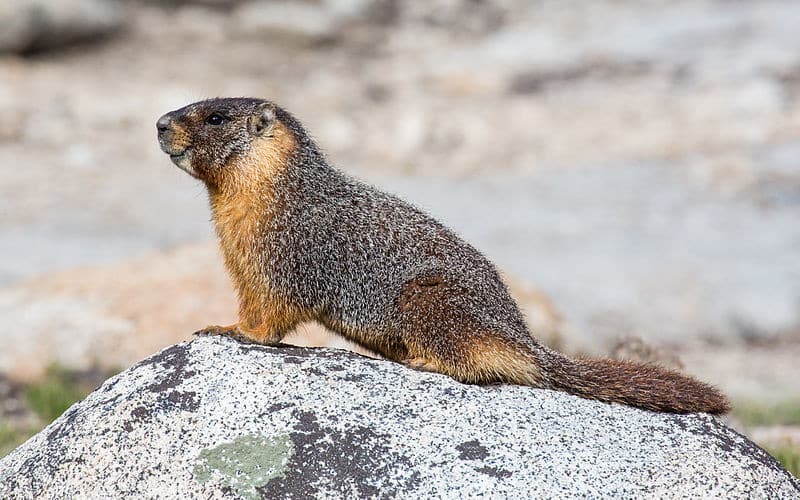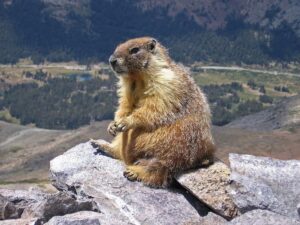The hoary marmot (Marmota caligata) is an amplified version of the eastern woodchuck. It is the largest American marmot and can weigh up to 30 pounds but will more likely be around 10 pounds. A rodent, in the squirrel family, it was known as “the whistler” to early explorers because of the long shrill sound it makes when alarmed.
This marmot has a grizzled-gray mantle over the shoulders and foreback. The lower back and rump are grizzled-brown, which is the result of the buffy-tipped underfur being half-hidden by long, stiff black-tipped guard hairs. Its feet are black, hence its species name, caligata, meaning “boots.” It has gray cheeks, gray underparts and a black band across the nose. Its soft color pattern is an excellent example of camouflage. This species has an unusual mid-summer moult. The summer colors are a little more brown in tone, and winter pelage is more “hoary.” Dwelling in the alpine tundra zone of northern mountains, the hoary marmot is found beyond the treeline as far as the limit of vegetation. Although here in Alaska, where treeline may be as low as 2,500′ (in Denali) marmots will also be found in rocky areas close to sea level.
Its den may be found under the border of a rockslide or on open hilly ground under some huge boulder or in the loose shale talus under a cliff. Large boulders provide protection against the grizzly bear’s efforts to dig out this creature. Its nest, hidden deep in the crevice, is composed of grasses. In the spring the winter nest is frequently thrown out of the burrow and replaced by a new one of fresh grasses. Well-beaten trails extend from the burrow entrance to feeding locations.
Hoary marmots live in loose colonies, taking advantage of their neighbors’ watchfulness. If danger aproaches, they pass the warning whistle along the valley and those feeding or sunning on a rock will gallop for home. They also take note of the alarm calls of some of their lesser neighbors such as pikas and ground squirrels. Their predators include grizzly and black bears, wolves and wolverines, and golden eagles, which are likely their main predator here in Denali National Park.

Diurnal in activity, hoary marmots spend about eight months of each year in a kind of hibernation. It is not actual hibernation but a lethargic, torpid state, during which breathing, pulse rate and body temperature are only slightly depressed. When they retire for the year they often plug the entrance to their burrow with rocks and mud and are sledom observed above ground after the first of September, not to be seen again until late April.
Marmots probably mate as soon as they emerge from their burrows. The young are born toward the end May or in early June and litters of four or five seem to be the average. Young marmots first appear in late July; they will not reach maturity until the second year and will typically live about five years.
As grazing animals they eat a large variety of green alpine grasses and forbs. One element of the climate that is important to the marmot is the wind because it controls certain insects (particularly mosquitoes) that annoy the animal and in extreme cases can prevent its foraging, as it keeps seeking refuge in the burrow.
The area around a marmots’ den often appears heavily grazed and they may travel several hundred yards to feed. They do not store food for winter, (except around their waist) as they become excessively fat in late summer prior to hibernation.
Indigenous peoples make fur garments from hoary marmot skins, a “sik-sik-puk” (marmot) parka is one of the most durable and beautiful of all parkas, and residents of northern Alaska prize them highly. Its flesh can also be eaten: however, no hunting season is provided for hoary marmots in Alaska.
The marmot occupies a beautiful alpine niche in the wilderness, along with Dall sheep, caribou and many other kinds of smaller mammals. The next time you have the pleasure of sharing this inspirational habitat, keep your ears tuned for the whistle that signals not just the marmots’ (or your) presence-it may alert you to a much more predatory visitor.




